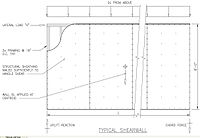
Photo from wikipedia
Abstract Masonry structures are very vulnerable during earthquakes, and masonry walls, as the main load-bearing members, are susceptible to in-plane shear generated by earthquakes. In order to compare the shear… Click to show full abstract
Abstract Masonry structures are very vulnerable during earthquakes, and masonry walls, as the main load-bearing members, are susceptible to in-plane shear generated by earthquakes. In order to compare the shear performance of masonry walls strengthened with different fiber-reinforced materials, in-plane shear tests were carried out on 20 masonry wall specimens. Mortar-, fiber-reinforced polymer (FRP)-, engineered cementitious composite (ECC)-, textile-reinforced concrete (TRC)- and bed joint-strengthening were mainly considered. The failure modes, shear strength, pseudo-ductility and energy dissipation of different strengthening methods were analyzed and discussed. Test results showed that unreinforced, mortar- and bed joint-strengthened masonry walls had different degrees of brittleness when they were damaged, and the FRP-, ECC-, and TRC-strengthening could improve this brittleness failure phenomenon. Under the experimental conditions in this study, the effects of ECC and TRC in shear strength enhancement were comparable comparative, and the shear strength of FRP was slightly smaller than the other two materials. The TRC-strengthened specimens had the best pseudo-ductility and energy dissipation, and the FRP-strengthened specimens were the poorest ones. The ECC-strengthened specimens were somewhere in between. Based on the collected test results of the popular TRC-strengthened masonry walls, the calculated and designed values were analyzed using the design method suggested by ACI 549.4R.
Journal Title: Construction and Building Materials
Year Published: 2020
Link to full text (if available)
Share on Social Media: Sign Up to like & get
recommendations!